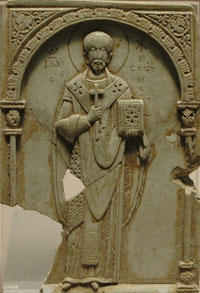The little horn of the fourth beast in Daniel chapter seven is understood to be the antichrist, although that word only appears in the New Testament. The proper use of the word from the Greek text is to say alter christus, which means another christ. The Apostle Paul wrote a letter to the church in Thessaloniki, Greece with a message concerning Yeshuah’s second coming, and the revelation of that man of sin, the son of perdition.
Now concerning the coming of our Lord Jesus Christ and our being gathered together to him, we ask you, brothers, not to be soon shaken in mind or troubled, neither by spirit nor by word, nor by letter seeming to be from us, to the effect that the day of Christ is at hand. Let no one deceive you by any means, for that day shall not come, except there come a falling away first, and that man of sin be revealed, the son of perdition; who opposes and exalts himself above all that is called God or object of worship, so that he as God sits in the temple of God, showing himself to be God. Do you not remember that when I was still with you I told you these things? And you know what is restraining him now so that he may be revealed in his time. For the mystery of iniquity is already at work. Only he who now restrains it will do so until he is taken out of the way. And then shall that wicked be revealed, whom the Lord Jesus shall consume with the breath of his mouth and shall destroy with the brightness of His coming. Even him, whose coming is after the working of Satan with all power and signs and lying wonders, and with all wicked deception for those who are perishing, because they received not the love of the truth, that they might be saved. And for this cause God shall send them strong delusion, that they should believe a lie: that they all might be condemned who believed not the truth, but had pleasure in unrighteousness. [2 Thessalonians 2:1-12]
The reason I find this interesting is because Paul needed to remind the church not to be hasty in expecting the return of Yeshuah any time soon, because there would first be a falling away, and that man of sin would be revealed. He reminded them, “do you not remember that when I was with you I told you these things? And you know what is restraining him now, so that he may be revealed in his time.” Paul is specifically referring to the little horn from Daniel chapter seven. He also reminds the church what is restraining that little horn while being careful not to identify it by name.
Here we have a point on which Paul affirms the existence of knowledge in the Christian Church. The early church knew, he says, what the hindrance was. The early church tells us what it did know upon the subject, and no one in these days can be in a position to contradict its testimony as to what Paul had by word of mouth only, told the Thessalonians. It is a point on which ancient tradition alone can have authority. Modern speculation is positively impertinent on such a subject… While the Caesars held imperial power, it was impossible for the predicted antichrist to arise…on the fall of the Caesars he would arise. [H. Grattan Guinness, Romanism and the Reformation, 1887]
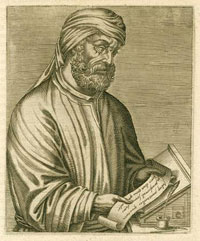
“Let no man deceive you by any means. For that day shall not come, unless indeed there first come a falling away,” he means indeed of this present empire, “and that man of sin be revealed,” that is to say, Antichrist, “the son of perdition, who opposeth and exalteth himself above all that is called God or religion; so that he sitteth in the temple of God, affirming that he is God. Remember ye not, that when I was with you, I used to tell you these things? And now ye know what detaineth, that he might be revealed in his time. For the mystery of iniquity doth already work; only he who now hinders must hinder, until he be taken out of the way.” What obstacle is there but the Roman state, the falling away of which, by being scattered into ten kingdoms, shall introduce Antichrist upon (its own ruins)? “And then shall be revealed the wicked one, whom the Lord shall consume with the spirit of His mouth, and shall destroy with the brightness of His coming.” [Tertullian, Ante-Nicene Fathers Vol 3, AD 200]
“Only there is one that restraineth now, until he be taken out of the way,” that is, when the Roman empire is taken out of the way, then he shall come. And naturally. For as long as the fear of this empire lasts, no one will willingly exit himself, but when that is dissolved, he will attack the anarchy, and endeavor to seize upon the government both of man and of God. For as the kingdoms before this were destroyed, for example, that of the Medes by the Babylonians, that of the Babylonians by the Persians, that of the Persians by the Macedonians, that of the Macedonians by the Romans: so will this also be by the Antichrist, and he by Christ, and it will no longer withhold. And these things Daniel delivered to us with great clearness. [John Chrysostom, Homily on 2 Thessalonians 2, Number 4, A.D. 390]
I have observed on the Apostle’s statement, that the Thessalonian Christians knew what the hindrance was that prevented this Man of Sin’s development: and we have the consenting testimony of the early Fathers, from Irenaeus, the disciple of St. John, down to Chrysostom and Jerome, to the effect that it was understood to be the Imperial power ruling and residing at Rome. [Edward B. Elliot, Commentary on the Apocalypse, Vol. III, 1862]
Paul did not identify the restraining power which they knew to be Rome, for fear of reprisals. Remember the Christian Church was under persecution by Rome. [Dr. Ron Thompson, Champions of Christianity in Search of the Truth, 1996]
Here is what Daniel recorded about this little horn:
After this I saw in the night visions, and behold, a fourth beast, terrifying and dreadful and exceedingly strong. It had great iron teeth; it devoured and broke in pieces and stamped what was left with its feet. It was different from all the beasts that were before it, and it had ten horns. I considered the horns, and behold, there came up among them another horn, a little one, before which three of the first horns were plucked up by the roots. And behold, in this horn were eyes like the eyes of a man, and a mouth speaking great things. [Daniel 7:7,8]
Then I would know the truth of the fourth beast, which was diverse from all the others, exceeding dreadful, whose teeth were of iron, and his nails of brass; which devoured, brake in pieces, and stamped the residue with his feet; And of the ten horns that were in his head, and of the other which came up, and before whom three fell; even of that horn that had eyes, and a mouth that spake very great things, whose look was more stout than his fellows. I beheld, and the same horn made war with the saints, and prevailed against them; Until the Ancient of days came, and judgment was given to the saints of the most High; and the time came that the saints possessed the kingdom. Thus he said, The fourth beast shall be the fourth kingdom upon earth, which shall be diverse from all kingdoms, and shall devour the whole earth, and shall tread it down, and break it in pieces. And the ten horns out of this kingdom are ten kings that shall arise: and another shall rise after them; and he shall be diverse from the first, and he shall subdue three kings. And he shall speak great words against the most High, and shall wear out the saints of the most High, and think to change times and laws: and they shall be given into his hand until a time and times and the dividing of time. But the judgment shall sit, and they shall take away his dominion, to consume and to destroy it unto the end. [Daniel 7:19-26]
Here are the 12 criteria for identifying the little horn:
- It rises out of the fourth beast (Rome) (Daniel 7:8)
- It rises among the ten horns (Daniel 7:8)
- It comes up after the ten horns (kingdoms) have been established (Daniel 7:24)
- It is different from the other ten (Daniel 7:24)
- It grows to be more stout than the other ten (Daniel 7:20)
- It subdues three of the other ten (Daniel 7:24)
- It has eyes like the eyes of a man and a mouth speaking great words against the Most High (Daniel 7:20,25)
- It makes war against the saints (Daniel 7:21)
- It presumes it can change times and change laws (Daniel 7:25)
- Its war against the saints, times and laws will continue for a time, times and the dividing of time (Daniel 7:25)
- It devours the whole earth (Daniel 7:23)
- It reigns until the Ancient of Days comes (Daniel 7:22)
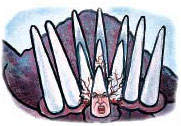
The ten horns of the beast, of course, correspond very naturally to the ten toes of the image; and these horns are plainly declared to be ten kings which should arise; and they are just as much independent kingdoms as are the beasts themselves; for the beasts are spoken of in precisely the same manner; namely, as “four kings which should arise.” Verse 17. They do not denote a line of successive kings, but kings or kingdoms which exist contemporaneously; for three of them were plucked up by the little horn. The ten horns, beyond controversy, represent the ten kingdoms into which Rome was divided.
We have seen that in Daniel’s interpretation of the image he uses the words king and kingdom interchangeably, the former denoting the same as the latter. In verse 44 he says that “in the days of these kings shall the God of heaven set up a kingdom.” This shows that at the time the kingdom of God is set up, there will be a plurality of kings existing contemporaneously. It cannot refer to the four preceding kingdoms; for it would be absurd to use such language in reference to a line of successive kings, since it would be in the days of the last king only, not in the days of any of the preceding, that the kingdom of God would be set up.
Here, then, is a division presented; and what have we in the symbol to indicate it? Nothing but the toes of the image. Unless they do it, we are left utterly in the the dark as to the nature and extent of the division which the prophecy shows did exist. To suppose this would be to cast a serious imputation upon the prophecy itself. We are therefore held to the conclusion that the ten toes of the image denote the ten parts into which the Roman empire was divided.
This division was accomplished between the years A.D.351 and A.D.476. The era of this dissolution thus covered a hundred and twenty-five years, from about the middle of the fourth century to the last quarter of the fifth. No historians of whom we are aware, place the beginning of this work of the dismemberment of the Roman empire earlier than A.D.351, and there is general agreement in assigning its close in A.D.476. Concerning the intermediate dates, that is, the precise time from which each of the ten kingdoms that arose on the ruins of the Roman empire is to be dated, there is some difference of views among historians. Nor does this seem strange, when we consider that there was an era of great confusion, that the map of the Roman empire during that time underwent many sudden and violent changes, and that the paths of hostile nations charging upon its territory, crossed and recrossed each other in a labyrinth of confusion. But all historians agree in this, that out of the territory of Western Rome, ten separate kingdoms were ultimately established, and we may safely assign them to the time between the dates above named; namely, A.D.351 and 476. [Uriah Smith, Daniel and the Revelation]
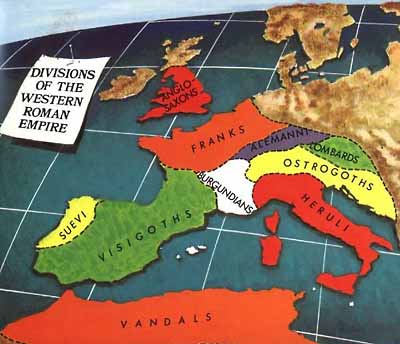
The identification of the ten horns of Daniel 7 is firmly established in history. In his excellent work Horae Apocalypticae, the historian Elliott provided two lists of the ten nations into which the Western Roman Empire disintegrated. His second list stated these ten to be the Alemanni, Anglo-Saxons, Franks, Burgundians, Visigoths, Suevi, Ostrogoths, Heruli, Bavarians and the Vandals. In his first list Elliott had substituted the Lombards for the Bavarians. A study of Gibbon’s classic Rise and Fall of the Roman Empire indicates that the Lombards hold the rightful place in the ten. [Russell and Colin Standish, Two Beasts, Three Deadly Wounds, and Fourteen Popes]
History records in the Arian controversy the series of conflicts leading to the elimination of the Heruli, the Vandals, and the Ostrogoths. These three horns were uprooted by the year 538 AD; the same point in time Vigilius ascended to the papal throne with the military support of Belisarius, officially making the Papacy a religious, political and military power.
Long ages ago, when Rome through the neglect of the Western emperors was left to the mercy of the barbarous hordes, the Romans turned to one figure for aid and protection, and asked him to rule them; … and thus …commenced the temporal sovereignty of the popes. So, meekly stepping to the throne of Caesar, the vicar of Christ took up the sceptre to which the emperors and kings of Europe were to bow in reverence through so many ages. [The American Catholic Quarterly Review, April 1911]
When the Roman Empire disintegrated and its place had been taken by a number of rude, barbarous kingdoms, the Roman Catholic church not only became independent of the state in religious affairs but dominated secular affairs as well. [CC Eckhardt, The Papacy and World Affairs]
If a man consider the origin of this great ecclesiastical dominion he will easily perceive that the Papacy is none other than the ghost of the deceased Roman Empire, sitting crowned upon the grave thereof. [Thomas Hobbes, Leviathan]
The Pax Romana has ceased. It is universal confusion. But wherever a bishop holds court, religion protects all that is left of the ancient order. A new Rome ascends slowly above the horizon. It is the heir of religion, the emperor is no more… but the Pontifex Maximus abides… He is now the vicar of Christ, offering the old civilization to the tribes of the north. He converts them to his creed, and they serve him as their father and judge supreme. This is the papal monarchy, which in its power and its decline overshadows the history of Europe for a thousand years. [W.F. Barry, The Papal Monarchy]
Out of the chaos of the great Northern migrations, and the ruins of the Roman Empire there gradually arose a new order of states, whose central point was the Papal See. Therefrom inevitably resulted a position not only new, but very different from the former. [The Church and the Churches (1862) by Dr. Dollinger, The Dublin Review, 1863]
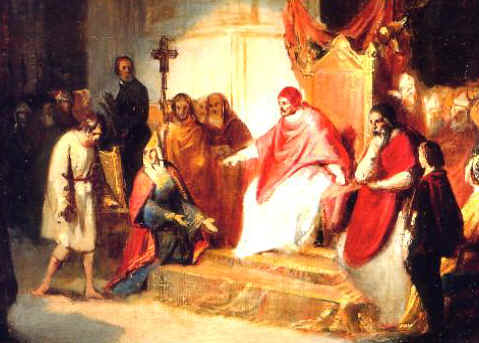
The power depicted by the little horn was greater than that of the other states. This implies a position of political superiority. Although it grew from littleness, it was to become greater than all the other powers. “More stout than its fellows” refers to the greater power which the papacy wielded in the affairs of Europe more than any of the other powers. From 800 AD when Charlemagne received his crown from the Pope, the papacy was to assume power over kings and nations. The “Humiliation of Canossa” is depicted in St. Peters, Rome, when in 1077, Henry IV, King of Germany, stood for three days, a penitent in the snow, before being permitted an audience with Pope Gregory VII. Likewise, King John of England in 1213 stood naked on a cold marble floor waiting for admission to the Pope’s presence in order to apologize to him. [Walter Veith, Truth Matters]
To them I would say, the Pontiffs, with their temporal power, have been accused of despotism; at least, then, let us give them the credit of having taught the people to submit. They have been also accused of tyranny over princes; at least, let us give them the honour of having taught kings that their power is limited. The dread chimera at which the English people especially stand in awe, the deposing power of the Pope, what was it but that supreme arbitration whereby the highest power in the world, the Vicar of the incarnate Son of God, anointed high priest, and supreme temporal ruler, sat in his tribunal, impartially to judge between nation and nation, between people and prince, between sovereign and subject? [Henry Manning, The Temporal Power of the Vicar of Jesus Christ]
The first six criteria for identifying the little horn with the Papacy are clearly seen in the history books as I have tried to briefly outline in the quotations used on this page.
- It rises out of the fourth beast (Rome) (Daniel 7:8)
- It rises among the ten horns (Daniel 7:8)
- It comes up after the ten horns (kingdoms) have been established (Daniel 7:24)
- It is different from the other ten (Daniel 7:24)
- It grows to be more stout than the other ten (Daniel 7:20)
- It subdues three of the other ten (Daniel 7:24)
